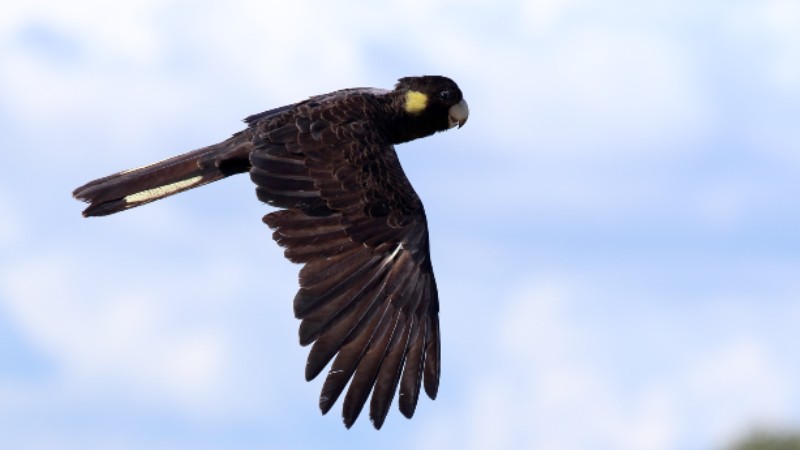

The male yellow-tailed black cockatoo courts by puffing up crest and spreading his tail feathers to display his yellow plumage. The breeding season varies according to latitude, taking place from April to July in Queensland, January to May in northern New South Wales, December to February in southern New South Wales, and October to February in Victoria, South Australia and Tasmania. The superb lyrebird can mimic the adult yellow-tailed black cockatoo's contact call with some success. Adults are normally quiet when feeding, while juveniles make frequent noisy begging calls. They also make a soft, chuckling call when searching for cossid moth larvae. Birds may also make a harsh screeching alarm call. kee-ow'', made while flying or roosting, and can be heard from afar. The usual call is an eerie high-pitched wailing contact call, ''kee-ow . Flocks will return to roost earlier in bad weather. They often socialise before dusk, engaging in preening, feeding young, and flying acrobatically. It is here that the cockatoos rest for the night, and also rest to shelter from the heat of the day. Tall eucalypts that are emergent over other trees in wooded areas are selected for roosting sites. Flight is fluid and has been described as "lazy", with deep, slow wingbeats. They generally keep to trees, only coming to ground level to inspect fallen pine or banksia cones or to drink. They are generally wary birds, although they can be less shy in urban and suburban areas. Outside of the breeding season in autumn or winter they may coalesce into flocks of a hundred birds or more, while family interactions between pairs or trios are maintained. They make long journeys by flying at a considerable height while calling to each other, and they are often seen flying high overhead in pairs, or trios comprising a pair and their young, or small groups. Yellow-tailed black cockatoos are diurnal, raucous and noisy, and are often heard before being seen. Crow species may appear similar when seen flying at a distance however, crows have shorter tails, a quicker wing beat, and different calls. Parts of its range overlap with the ranges of two cockatoo species that have red tail banding, the red-tailed cockatoo and the glossy black cockatoo. The yellow-tailed black cockatoo is distinguished from other dark-plumaged birds by its yellow tail and ear markings, and its contact call. The elongated bill has a pointed maxilla, suited to digging out grubs from tree branches and trunks. The lower beak blackens later by four years of age. Immature birds have duller plumage overall, a horn-coloured bill, and grey eye-rings The upper beak of the immature male darkens to black by two years of age, commencing at the base of the bill and spreading over ten weeks. The female has grey eye-rings, a horn-coloured bill, and brighter and more clearly defined yellow cheek-patches.
YELLOW TAILED BLACK COCKATOO PRICE PATCH
The male yellow-tailed black cockatoo has a black bill, a dull yellow patch behind each eye, and pinkish or reddish eye-rings. It has a short mobile crest on the top of its head, and the plumage is mostly brownish-black with paler feather-margins in the neck, nape, and wings, and pale yellow bands in the tail feathers. Usually only one chick survives which fledges after 28-29 days and remains with the parents until the next breeding season.The yellow-tailed black cockatoo is 55–65 cm in length and 750–900 grams in weight. Two eggs are laid and incubated by the female only. The nest is a large tree-hollow lined with a bed of woodchips. Larvae are extracted from the stems of trees by using their large bills to tear strips of bark away from the trunk and gauge deep into the wood.īreeding occurs from October to March in South Australia. They have learnt to extract seeds from the cones of exotic pines by tearing the cones apart. Yellow-tailed Black Cockatoos feed on seeds and insect larvae. Although regarded as “Vulnerable”, large flocks of up to 200 birds or more may nevertheless be regularly seen in winter in the Mount Lofty Ranges.

Their distinctive flight silhouette with a large rounded head, deep leisurely wing beats, and echoing “whee-la” calls make them easy to recognise. Sightings of small groups of these magnificent birds became increasingly common in suburban and rural areas after they learnt to exploit the cones of exotic pines as a food source. A pair of Yellow-tailed Black Cockatoos, with female in front.


 0 kommentar(er)
0 kommentar(er)
